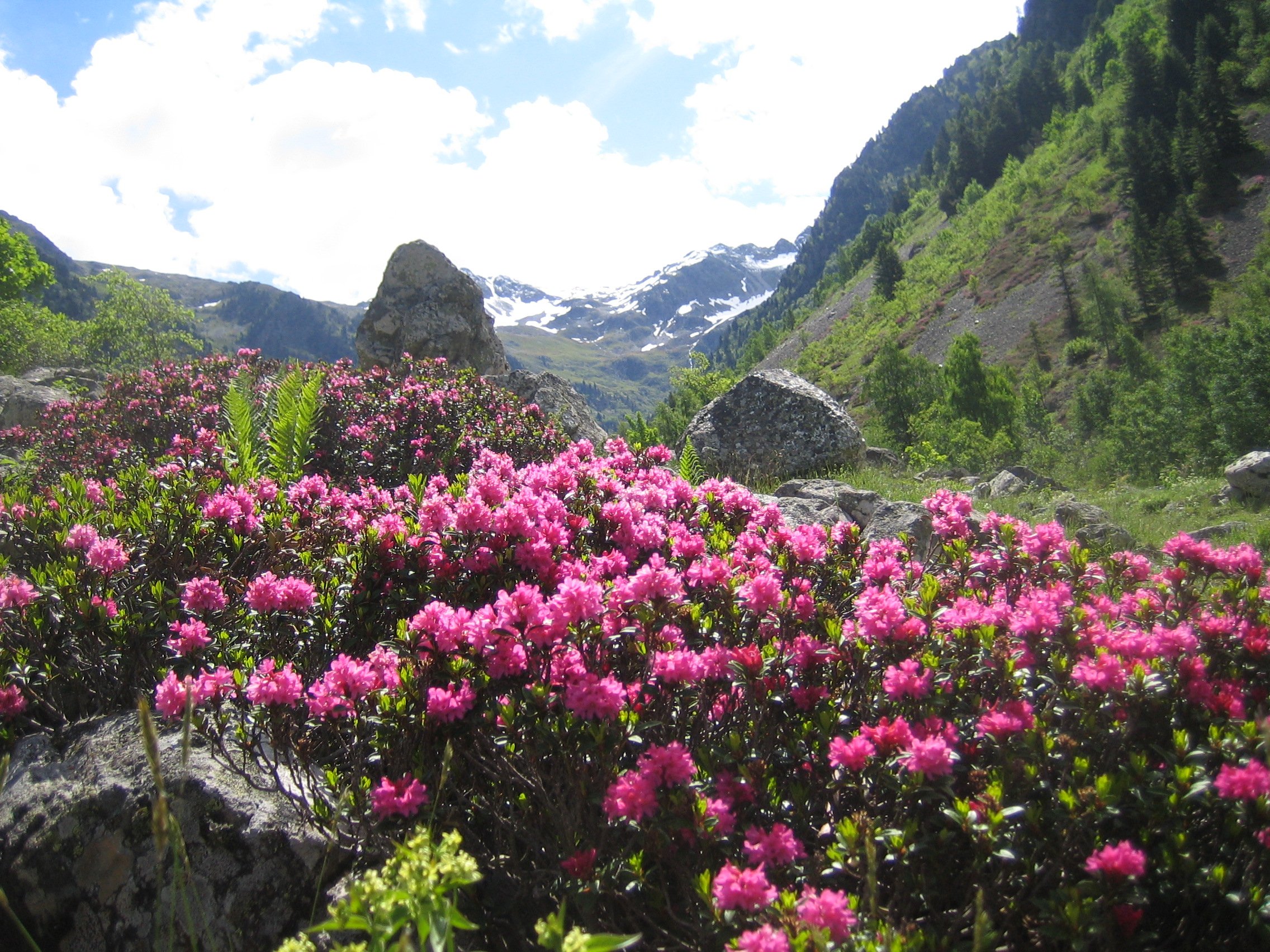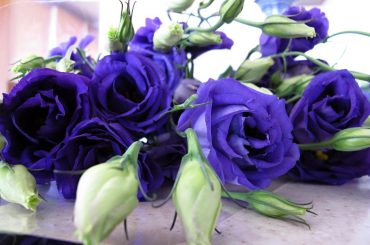Table of Contents
Do you know that you can guess the coldness of the place just by looking at your rhododendron? This is because these plants tend to change their leaves’ appearance with the change in the temperature or chilly weather conditions. Well, this is not the only reason why Rhododendrons have wilted & curled leaves. However, these plants look extremely beautiful and add elegance to your garden. Also, rhododendrons are fragrant and have attractive foliage.
These plants are easy to care for and are low maintenance, making it easy for you to opt for these for your home garden. There are many reasons why rhododendrons have wilted & curled leaves, and once you know them, you can take better care of them.
In this article, we got everything covered for you to sort problems with rhododendrons in pots as well so that you can plant these on your balcony or terrace too. Tune in to know everything.
What Are Rhododendrons?
These are beautiful flowering shrubs primarily found in Asia, Europe, and North America. However, Rhododendrons are well known for their large foliage and showy flowers that have a variety of colours. It comes in vibrant colours like pink, red, and purple, and also in a subtle white colour.
The growing season of rhododendrons is short. Thus it makes it essential to understand its growing pattern and act according to it in order to have beautiful flowers. Its growing season varies depending on the climate of the place and also on the specific variety of the plant. These shrubs grow in the early spring, mostly around March or April, as the weather conditions get warmer. However, the growth of this plant depends on the sunlight and temperature, making it the first plant to bloom in the spring.
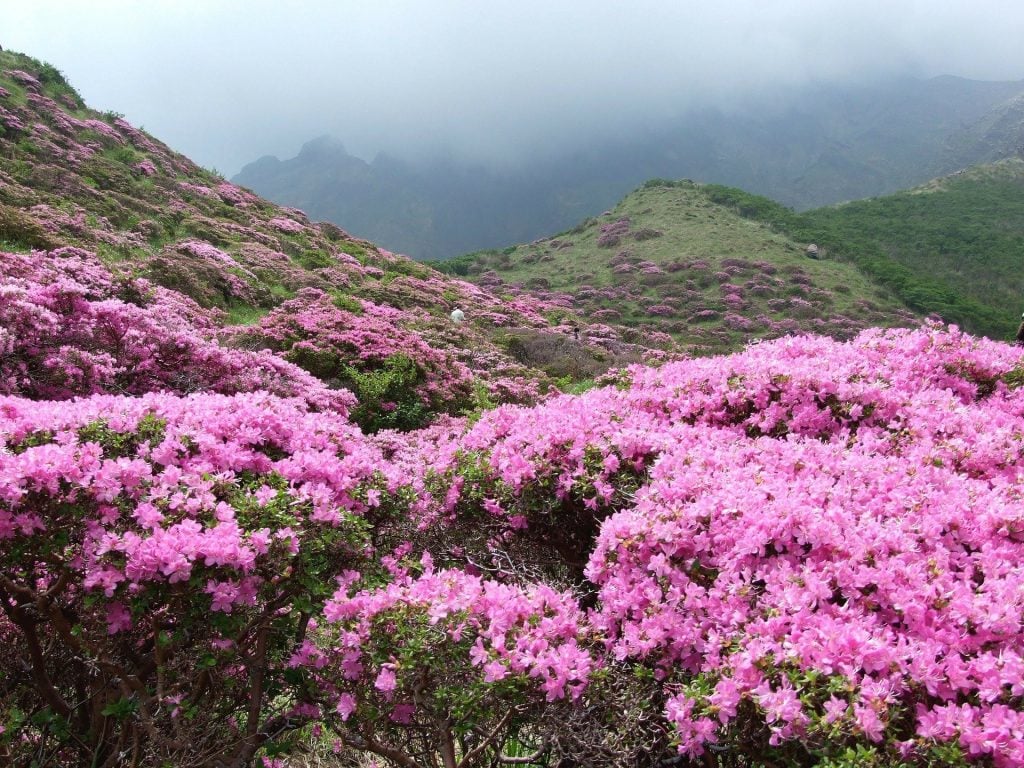
While planning to grow rhododendrons, you need to look out that these plants are receiving plenty of water, sunlight, and nutrients to thrive in their growth. The main problem with rhododendrons in pots is that they do not receive these basic necessities properly, making it difficult to have proper growth. Also, they prefer well-drained soil along with slightly acidic in nature with a pH between 4.5 and 6.0. If the soil is too alkaline, then the plants won’t be able to absorb the nutrients and will have yellow leaves.
Reasons Why Rhododendrons Have Wilted & Curled Leaves
When you plant rhododendrons in your garden or in any pot, you tend to see some changes in their leaves. This is caused due to several reasons. We have mentioned some major factors in wilting and curling of this shrub’s leaves-
1. Chilling Temperatures
Since Rhododendrons are hardy plants, they can tolerate the extreme winters of the UK. However, some cultivars face difficulties in adapting themselves to extreme temperatures, and they tend to show signs of stress, especially in the winter season. Such plants usually recover after the fall is over in the milder conditions. Thus, if your Rhododendrons have curling leaves, then that is its defense mechanism or natural response to cold, known as thermotropism. The major problem with rhododendrons in pots is that it curls leaves inwards. This is because the inward folds leave less surface of the leaves exposed to dry cold winds. Also, because of this, it prevents too much water from evaporating from the leaves. Rhododendrons need plenty of water, and if you find that the conditions have been dry for too long, then you can conserve that water by laying an organic mulch around the base of the plant.
2. Stem Damage
Sometimes you notice an irregular change in the growth of the plant, such as one portion of the plant has wilted and curled leaves. The first thing to check in such a situation is whether there is any broken or damaged stem. This is common if the flow of nutrients and water stops, then leaves will be wilted or droop. Storms or other extreme weather conditions can cause stem damage. This is more common when your shrub is placed in an exposed location. The only thing to do in such a situation is to prune out the damaged parts to avoid the excess stress on the rest of the plant.
3. Water Shortage
In the list of the reasons why rhododendrons have wilted & curled leaves, this is the most common problem that these shrubs face. Since they require a lot of water and when their requirements are not fulfilled, they tend to show their stress through their leaves. Especially in the summer seasons, water is the main culprit for the drooping of the leaves. This happens because rhododendrons have shallow roots and require moist soil. Thus it is necessary to supply water in the dry periods. You can also spray rainwater on the foliage of the plant. This water shortage is one of the common problems with rhododendrons in pots, as they have higher needs when grown in limited space.
4. Excessive water
Excess of anything can hinder the growth of the plant, and this is also one of the most common factors for the drooping leaves of the plant. As mentioned, rhododendrons need moist soil and plenty of water but will not do well if the soil gets waterlogged. In the rainy season, when there is heavy rain then, the soil does not drain freely, and that cause problem with rhododendrons. In such a situation, mulching is the best alternative. This is because it aids in developing healthy, airy, and free-draining soil. This is one of the most common problems with rhododendrons in pots or containers. If this problem occurs, make sure to have a potting mix that is moisture-retentive yet well draining.
5. Fungus
Fungal infections are primarily caused due to the problem of waterlogging and can cause the leaves of rhododendrons to wilt. There are three main diseases that your plant can have-
1. Phytophthora Dieback
When the leaves are curled inwards, then that is a symptom of rhododendrons dieback. This is mostly caused by the fungus Phytophthora cactorum, also known as ‘water mold,’ caused due to poorly drained soil. The bottom of the stem weakens and loose colour. Also, its roots will look blackened and soggy, and if you try to pull up the roots, the stem might lose its grip and break. These are also common symptoms to look for when your plant is not in a healthy state.
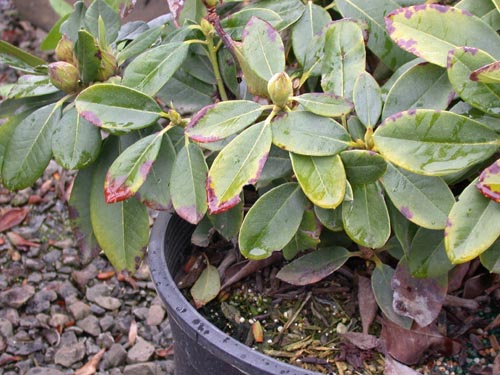
2. Phytophthora Root Rot
This is the most common fungus that hinders the growth of the plant caused by Phytophthora cinnamomi. It is primarily caused in warm and wet soil when there is no proper draining in the soil. In such a situation, the leaves suddenly droop, and the rhododendron can not survive for longer than a week. The symptoms that you may notice are that the root near the soil will become brittle and turn reddish-brown. This fungus mostly occurs in areas where water gets collected near the rhododendron roots.
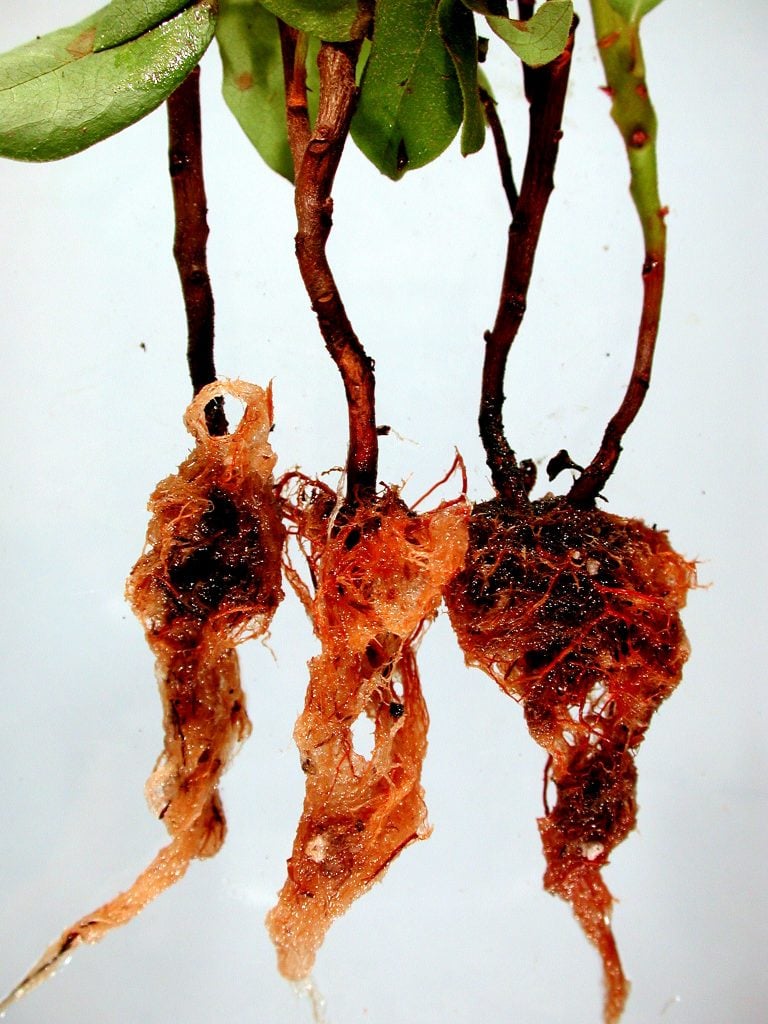
3. Honey Fungus
Rhododendrons, along with other woody perennial plants, suffer from this fungus. However, this is a more hazardous fungus as it will cause root death to the plant before the wilting and drooping of leaves. In the roots, there is white mycelium present when the plant is attacked by this fungus which particularly smells like mushrooms. These were the main fungus infections that your plant could have. Usually, rhododendrons are not prone to fungus, but dues to water problems, it can happen. If your plant growth is hindered by any of these fungi, then dispose of it and replace the topsoil from the root area.
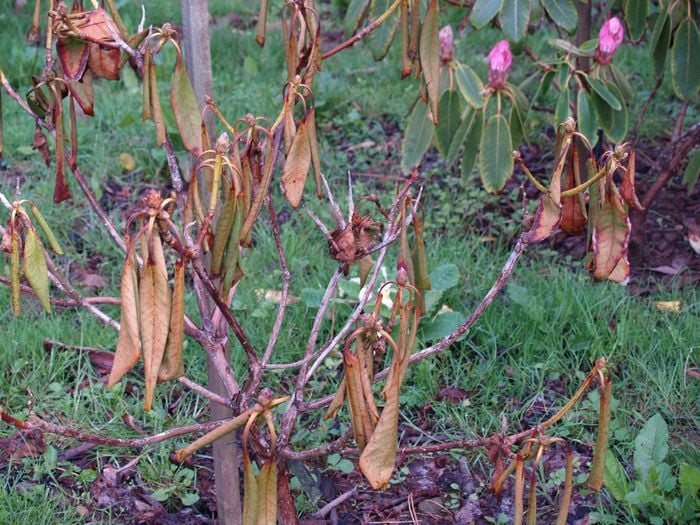
6. Vine Weevils
Pets and vine weevils can be one of the reasons why rhododendrons have wilted & curled leaves. However, it is mainly caused problems with rhododendrons in pots or containers. The adult vine weevils eat the edges of the plant’s leaves, but the major problem is caused by the larvae of the vine weevils. This is because they feed on plant roots over the autumn and winter season, causing wilting and death of the shrub. Moreover, you can deal with this issue manually by picking it from the roots of the plant or by placing compost at the bottom. This can be time taking, but it surely helps in the growth of the plant. You can also you biological controls such as nematodes in the month of August or early September.
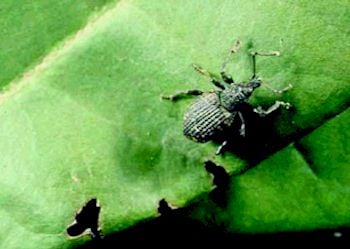
How to Care for Rhododendrons?
To ensure the healthy growth of the plant in order to receive beautiful blossoms, you need to take care of them properly-
- Water them properly, especially in the growing season. Keep the soil moist but do not waterlog.
- Provide a balanced, slow-release fertiliser as rhododendrons receive benefits from it. Apply fertilisation in the early spring before the growth of new plants. Also, in the late fall, after the leaves have fallen off.
- Pruning is not much required, but remove any dead or damaged branches in the early spring before new growth appears.
- Mulch the plant from time to time around the roots as it helps in retaining moisture and protect it from extreme temperatures.
- Protect them from pests and diseases as they are more prone to them.
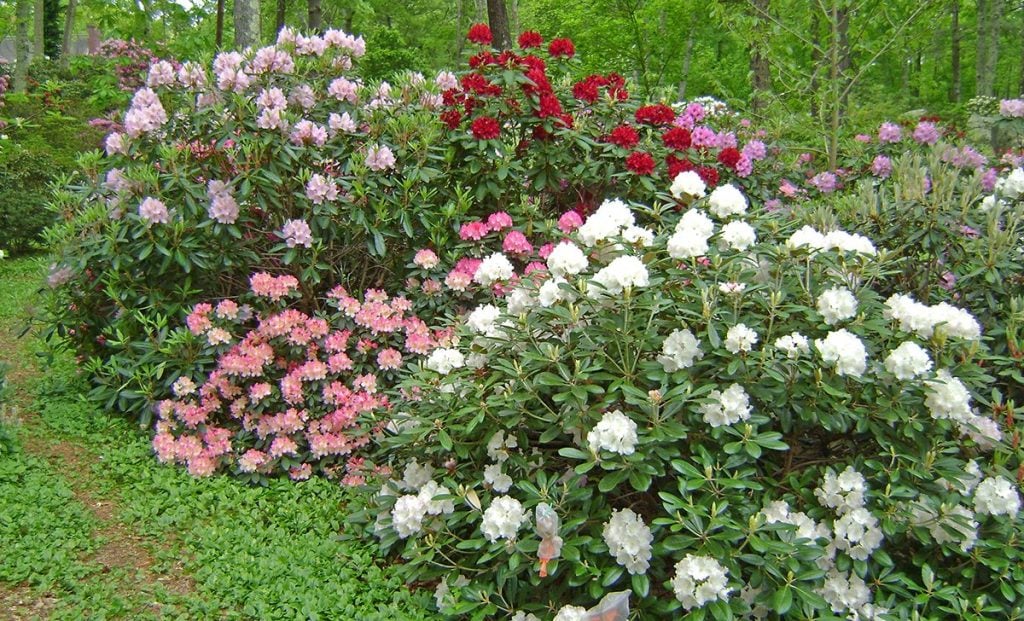
Feeling Confident About Growing Rhododendrons?
In the beginning, all you had was a little knowledge about rhododendrons. But now you have all the reasons why rhododendrons have wilted & curled leaves. However, you cannot control the weather conditions in your locality, but surely you can take preventive measures to protect your beautiful plant. Moreover, now you also have a keen understanding of resolving all the issues faced by your plant in your garden. Make sure to follow all the dos and don’ts to yield desired results from your plant.
While planting rhododendrons in a pot or container, you can have some challenges as these plants grow tall and spread extensively as well. However, we have mentioned some measures to keep in mind before you grow rhododendrons in a small space or container. So now all you need is time to invest in your plant in order to have an attractive yield of flowers.

